Possibly useful information:
For reflection,
For refraction, n1 sin
n = c/v
image equation
apparent depth di = do (n1/n2)
Young’s Double Slit:
PHY1161G
Exam #3
November 1, 2000
Possibly useful information:
For reflection, ![]() inc
=
inc
= ![]() ref
ref
For refraction, n1 sin ![]() 1
= n2 sin
1
= n2 sin ![]() 2
2
n = c/v
![]()
image equation ![]()
apparent depth di = do
(n1/n2)
Young’s Double Slit: ![]() = d sin
= d sin ![]()
d sin ![]() = m
= m
![]() , maxima for m =
0, 1, 2, . . .
, maxima for m =
0, 1, 2, . . .
d sin ![]() = (m +
1/2)
= (m +
1/2) ![]() ,
minima for m = 0, 1, 2, . . .
,
minima for m = 0, 1, 2, . . .
diffraction grating: ![]() = d sin
= d sin ![]()
d sin q = m l maxima for m = 0, 1, 2, . . .
diffraction by a slit: D = D sin ![]()
First minimum for D = D sin ![]() =
= ![]()
sin ![]() =
= ![]() / D
/ D
![]()
![]()
![]() / D
/ D
Minima for D = D sin ![]() = m
= m ![]() , m =
1, 2, 3, . . .
, m =
1, 2, 3, . . .
optical resolution: ![]() 1.22(
1.22( ![]() / D )
/ D )
polarization: S = So cos2 ![]()
thin films: ![]() ’
=
’
= ![]() / n
/ n
2t = m ![]() ’ =
m(
’ =
m( ![]() / n); max, m
= 0, 1, 2, . . . n1 < n2 <
n3
/ n); max, m
= 0, 1, 2, . . . n1 < n2 <
n3
2t = (m+1/2) ![]() ’
= (m+1/2)(
’
= (m+1/2)( ![]() / n);
/ n);
min, m = 0, 1, 2, . . . n1 < n2 <
n3
2t = m ![]() ’ =
m(
’ =
m( ![]() / n); min, m
= 0, 1, 2, . . . n1 < n2 >
n3
/ n); min, m
= 0, 1, 2, . . . n1 < n2 >
n3
2t = (m+1/2) ![]() ’
= (m+1/2)(l
’
= (m+1/2)(l![]() / n);
/ n);
max, m = 0, 1, 2, . . . n1 < n2 >
n3
Simple Magnifier: Mang = r / f
= 25 cm / f
Microscope: ![]()
Telescope: ![]()
We have covered lots of good things in this section! There may,
indeed, be too many questions. So budget your time wisely.
Statistics:High: 96Mean: 65
Low: 18 (then 29)
1. (23.20) A SCUBA diver, underwater, shines a light up
toward the smooth surface of the water (n = 1.33) with an angle of
incidence of 30°. At what angle does the light leave the
water?
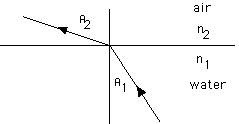
We begin with Snell’s law,
![]() 2 =
41.7°
2 =
41.7°
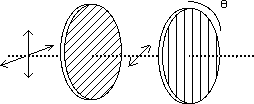
The intensity is given by
[This is contained in the text, on page 885, before Example 23.8; the equation given in Example 23.8, at the top of page 886, is NOT correct].
b) Consider two parallel polarizing filters, A and B, as shown below. Another polarizing filter, C, is placed between them. As this third polarizing filter C is rotated through a full 360°, how many times does the beam of light cycle from dark to bright?
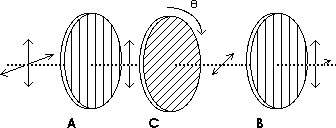
The light coming from a polarizer is always aligned with the direction of the polarizer.
If polarizer C is perpendicular to polarizer
A, no light will get through. If polarizer C is
perpendicular to polarizer B, no light will get
through. But polarizers A and B are parallel.
Therefore, polarizer C will be perpendicular to both A
and B twice as it is rotated through
360o.
c) Consider two perpendicular polarizing filters, A
and B, as shown below. Another polarizing filter, C, is placed
between them. As this third polarizing filter C is rotated through a
full 360°, how many times does the beam of light cycle from dark
to bright?

The light coming from a polarizer is always aligned with the direction of the polarizer.
If polarizer C is perpendicular to polarizer A, no light will get through. If polarizer C is perpendicular to polarizer B, no light will get through. Polarizers A and B are perpendicular. Therefore, polarizer C will be perpendicular to either A or B four times as it is rotated through 360o.
Locate the image.
Describe the image:
Always start with a clear ray diagram; this is more
useful to understanding than just solving the equation. Always
ask if the solution to the equation is consistent with
your ray diagram.
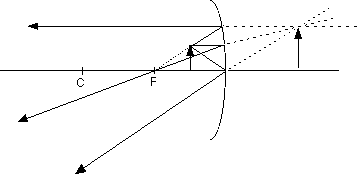
Now we are ready for the image equation,
The focal length is one-half the radius of curvature
f = 120 cm/2 = 60 cm
Your face is the object so the object distance is do = 25 cm
![]()
1 / di = .01667 - .04
1 / di = - 0.02333
di = 1 / ( - 0.2333)
di = - 43.9 cm
The negative sign means this is a virtual image.
We can find the magnification from
The magnification is M = 1.76. This positive
magnification means the image is
upright. Since M > 1,
the image is
enlarged.
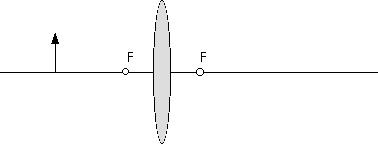
4. Consider an object placed 30 cm from a converging lens
with a focal length of 10 cm.
Locate and characterize the image:
Where is the image located?
Is the image real/virtual; upright/upside-down; smaller/larger?
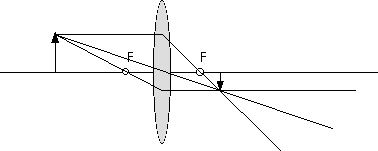
From the ray diagram, we can see that the image is
real,
inverted, and
smaller.
Now, let’s do the numerical calculation:
Now, the magnification: M = - [
di / do ]
The image is inverted and one-half the height of the object.

5. A HeNe laser (![]() = 634 nm) shines light onto a double slit with slit separation
distance of d = 0.2 mm. An interference pattern of dark and bright
areas is produced on a screen 2 m from the double slit. What is the
distance between the bright central maximum and the first dark area
on either side of it?
= 634 nm) shines light onto a double slit with slit separation
distance of d = 0.2 mm. An interference pattern of dark and bright
areas is produced on a screen 2 m from the double slit. What is the
distance between the bright central maximum and the first dark area
on either side of it?
A maximum occurs for
But we need the angle for a minimum.
Minima occur for
This first minimum is for m = 0, so
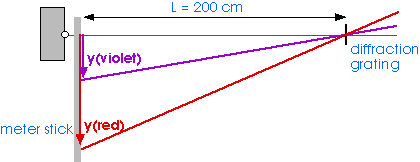
6. As in the lecture demonstration, a light source consists
of a long, thin tube or filament. A meter stick is placed very near
the light source. At a distance of L = 2.0 m, there is a
diffraction grating with 750 lines / mm.
a) What is the separation distance d between the lines in the
grating?
When you look at the light source, where -- how far from the light
source, along the meter stick -- will you see the spectrum spread
out?
b) At what position will you see red light with ![]() = 700 nm?
= 700 nm?
c) At what position will you see violet light with ![]() = 400 nm?
= 400 nm?
First, the diffraction line separation,
Units are important! Don't forget to carefully consider and include units!
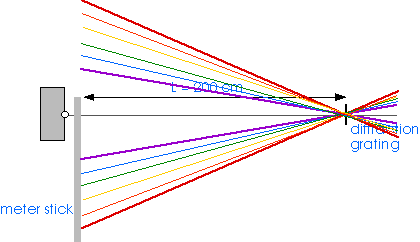
Light will be bent by the diffraction grating at angles that correspond to the wavelengths according to
We are concerned only with the first-order spectrum, so m = 1 and
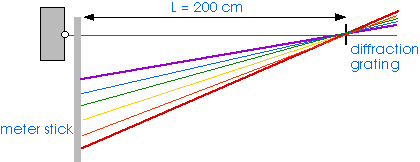
d sin ![]() =
=
![]()
sin ![]() =
= ![]() /d
/d

For red light,
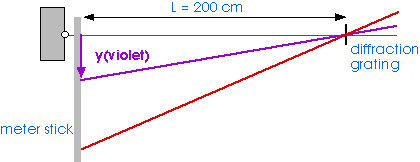
For violet light,